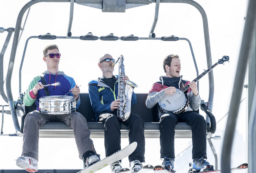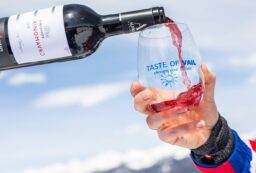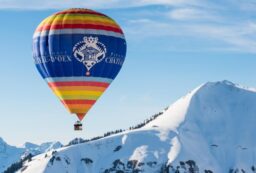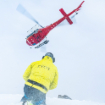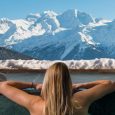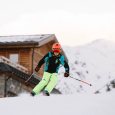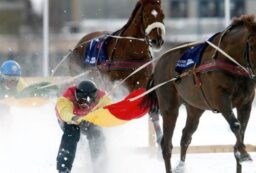
Breath streams like dragon smoke from the horse’s nostrils as it thunders through the winter air—in its wake, a wave of white. Through this spray of snow, a heroic profile soars through the air on a pair of skis and lands with teetering triumph, clinging to a lifeline that yanks him forward.
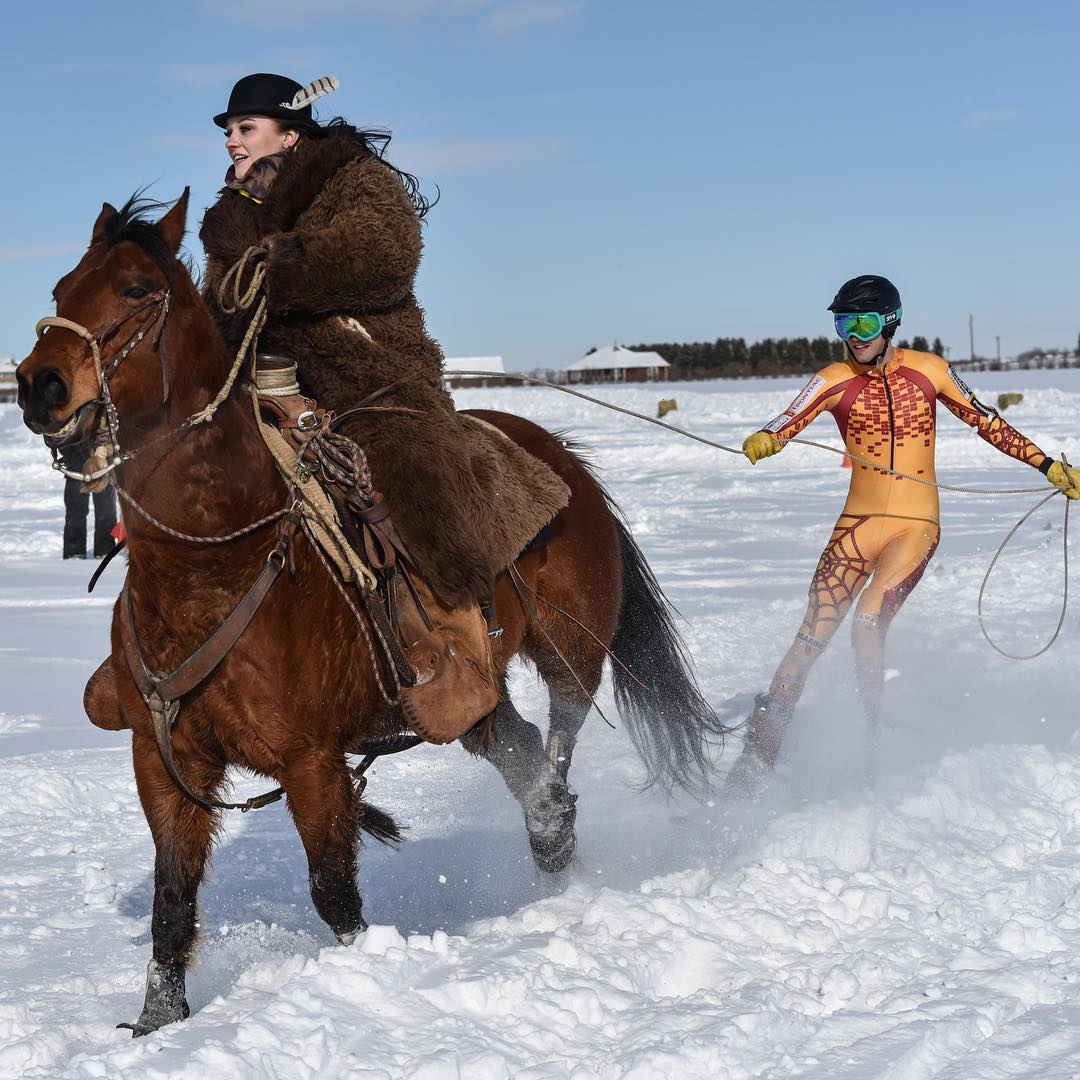
The dramatic, wide angle shot of a horse and rider at full speed pulling someone on skis might be a picture of madness, but in the moment, the skier himself doesn’t have time to consider the consequences. Instead, he’s confronted with two agendas at a pace too fast to think: he must complete this obstacle course, and he must reach the finish line alive.
Skijoring (the J is silent if you live East of the Atlantic) is Norwegian for “ski driving,” and for the past 200 years has gained traction amongst adrenaline junkies across the globe. Though the sport differs on both sides of the Atlantic, every rendition entails a horse-powered extreme ski race in which hooves are fitted with special snow shoes for additional traction, and tear up snow as they haul the skiers behind them at speeds of up to 50 miles per hour.
Background History
This adrenaline-inducing athleticism originated in Scandinavia in the 1800s with a purely practical purpose: it was the fastest way to transport army dispatches in the winter. Though dogs or reindeer pulling skiers across a boundless winterscape were not uncommon substitutes, horses’ heightened speed caught on with local daredevils. The competitive sport of skijoring spread across Europe and grew to such popularity that it became a part of the Nordic Games, a precursor to the Winter Olympics.
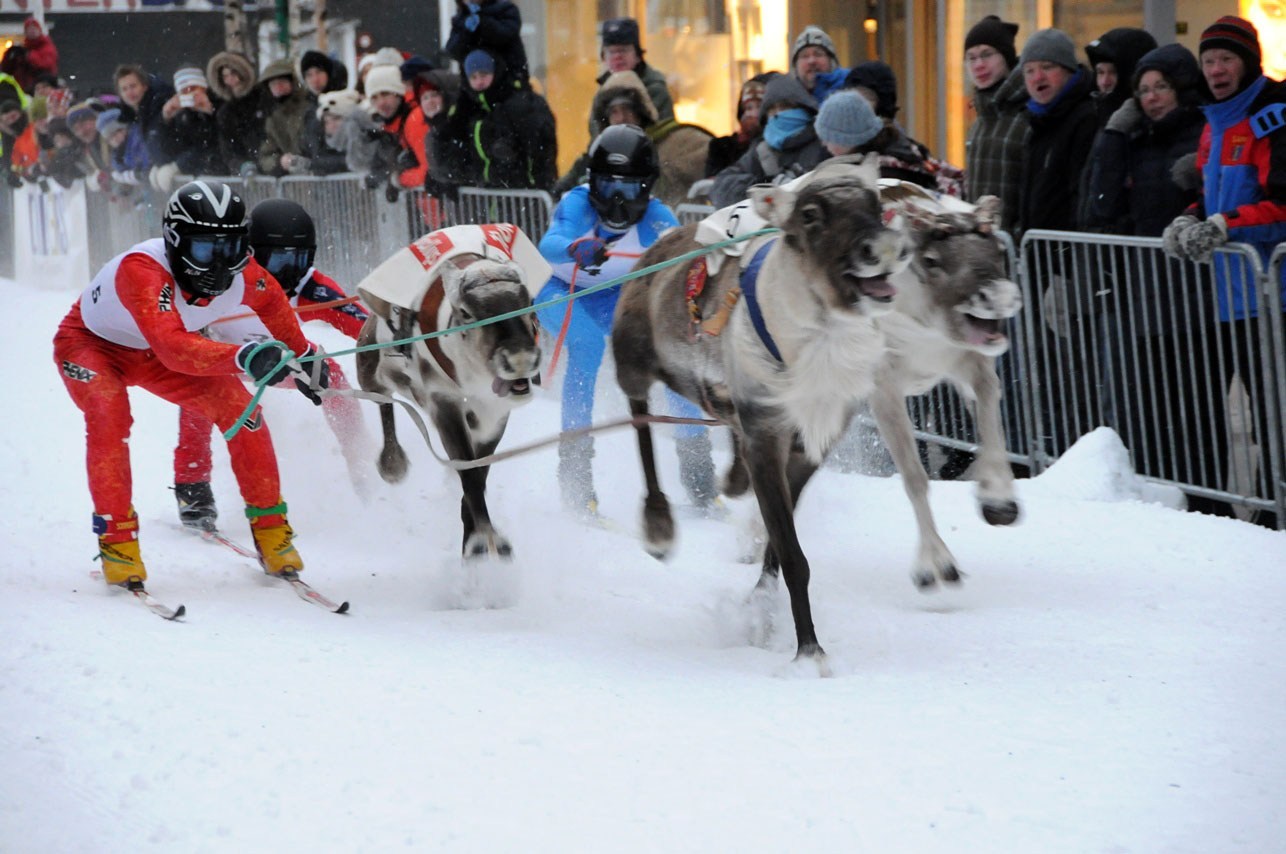
Europe follows the original Nordic version of the sport, in which jockeys on skis maneuver riderless horses and jostle each other on a track. One such race was staged as a demonstration sport at the 1928 St. Moritz Winter Olympic Games, but after its initial trial run, the sport has never reached Olympic status.
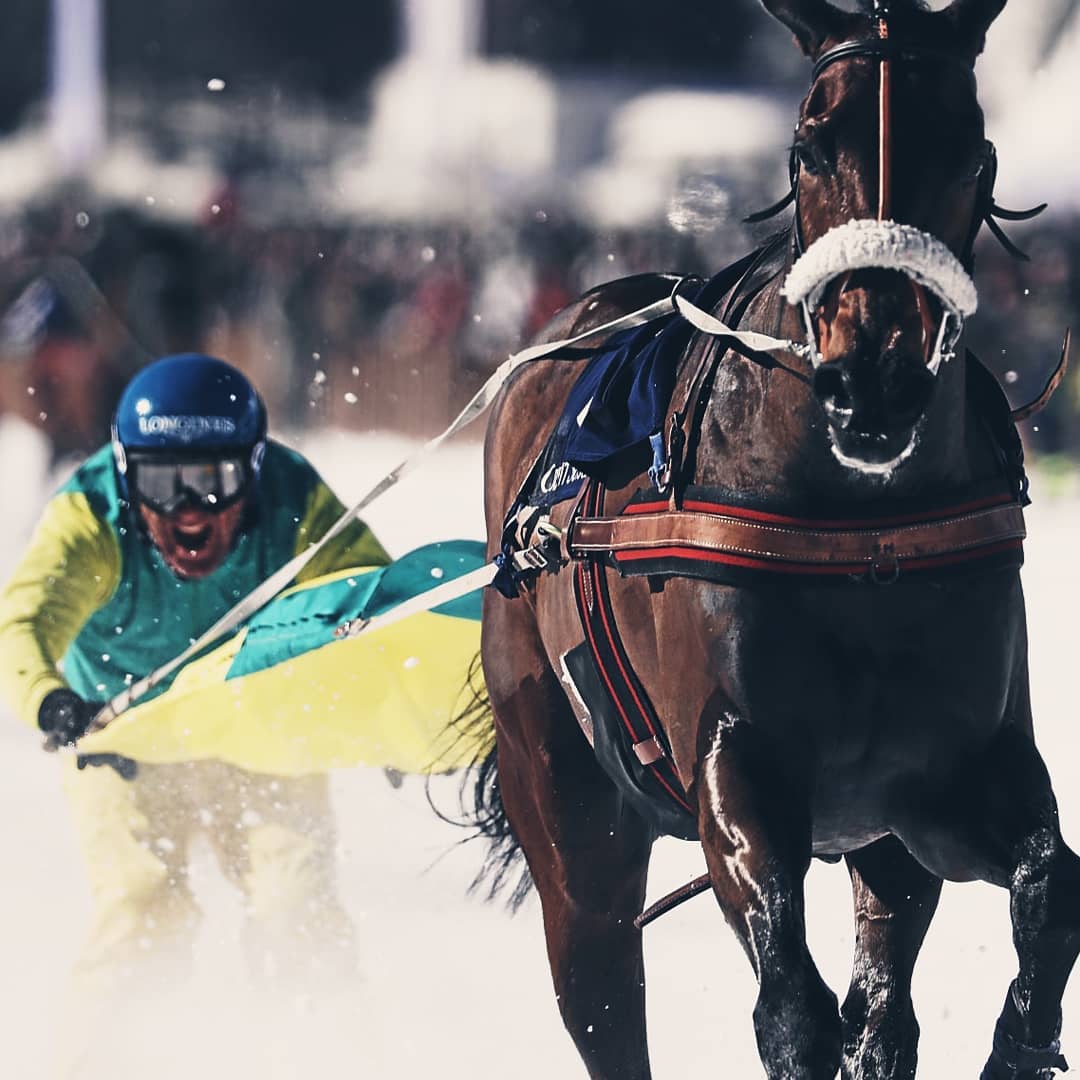
A skijoring race at St. Moritz, however, has since become an annual tradition and evolved into the most elite skijoring competition, attracting accomplished athletes and an affluent audience. The race has a prominent place among the exclusive White Turf thoroughbred racing events held on the frozen St. Moritz lake each February. Nestled in the Central Eastern Alps, the frozen lake is transformed into a pristine, crystalline track, making for a uniquely dazzling atmosphere with the promise of snowlight and suspense. Social elite from around the world gather trackside, bundled up in faux furs to enjoy the excitement with a side of champagne. The crunch of ice under galloping hooves on St. Moritz Lake is as exhilarating for the spectators as it is for those competing.
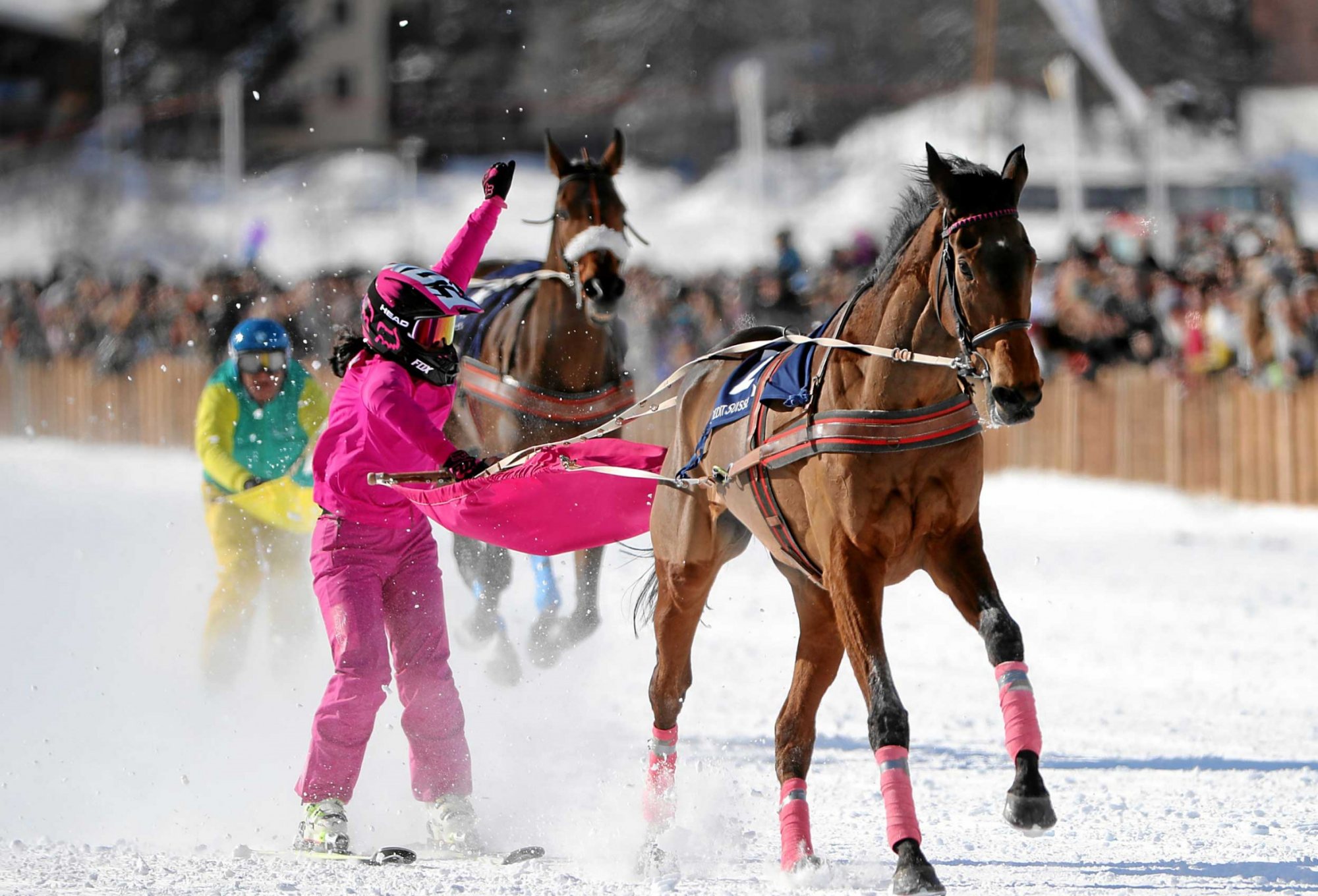
"Europe follows the original Nordic version of the sport, in which jockeys on skis maneuver riderless horses and jostle each other on a track."
Steamboat Springs, Colorado
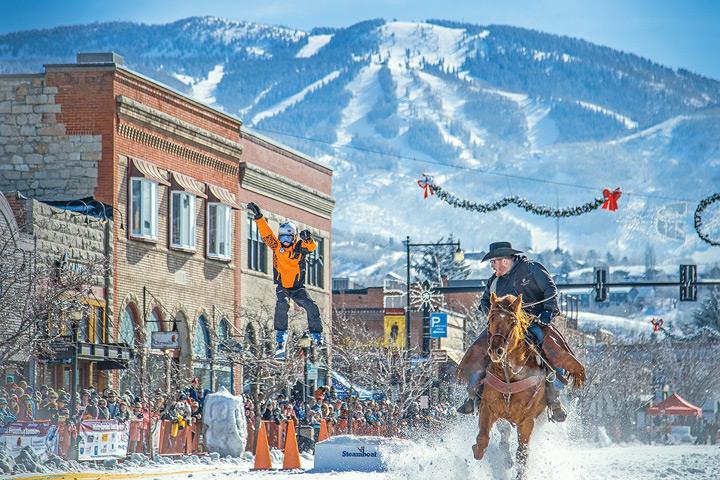
The American take on this exciting race borrows from the spirit of America’s Wild West, by enhancing the sport with even more adrenaline and athleticism. Skijoring has evolved across the Atlantic into an extreme series of maneuvers, where competitors take on the course one at a time and tackle jumps up to six feet high—though the horses aren’t the ones doing the jumping. A horse and rider team pulls each skier by a 30-foot rope across an obstacle course. Skiers must maneuver themselves to navigate ramps and gates and collect rings, often against the clock. While some more challenging courses have built in twists and turns, a typical track is a 900-foot straightaway, enough distance for the horse to ramp up to full speed. A full round lasts about 20 seconds.
This extreme winter sport has reached national acclaim at popular western ski destinations, and follows a seasonal circuit across the western states. Steamboat Springs, Colorado hosts one of the most renowned skijoring competitions in America as the highly anticipated event at the annual winter carnival. A snow-packed Main Street in February attracts crowds along the entirety of the snow-banked sidelines to watch hooves and skis tear it up—everyone dressed in preparation for the spray of snow that erupts from the entertainment. And in the event that snow is also in the forecast, as it often is, the cheers only get louder as the weather makes the race more exciting.
Jackson Hole, Wyoming

"Skijoring is Norwegian for “ski driving,” and for the past 200 years has gained traction amongst adrenaline junkies across the globe."
Jackson Hole, Wyoming is another go-to destination for the American skijoring scene. Bundled up against the cold, spectators line both sides of this Main Street’s snow-packed straightaway and breathe a mist of excitement into the frosty air. An announcer in a cowboy hat introduces each racer with bravado before each run, spewing stats into a microphone as fast as the hooves galloping past. All eyes focus anxiously on the rope connecting skier and horse as they speed by—this lifeline makes for the unequivocal thrill that keeps crowds coming back for more.
While coordination, agility, and a fearless spirit are key components for any competitor bold enough to take the rope at Jackson Hole, these adrenaline junkies will attest that the greatest challenge is simply maintaining proper tension in the rope. Too much slack on the back end of a jump is grounds for whiplash, and a sure-fire way to wipeout in a tangle of skis and snowdrift. No matter how much mastery these competitors will ever achieve at this sport, the potential for a crash is always imminent. In many cases, an epic nose-dive gets just as much applause as a successful round.
Zell am See, Austria

But for all the additional thrills the sport acquired as it caught on in the west, Europe has recently added even more exhilaration—and horsepower—to keep skijoring up to modern speed. The newly revived Zell am See Ice Race in Austria clears frozen Lake Zell to carve out a winter racetrack, trading horses for Porsches.
Early February brings extra life to this famous ski town for this uproarious occasion. Though the event includes a series of races showcasing classic cars on the ice, the skijoring events attract the largest crowd. Porsche 911s rev their engines, raring to go, the skiers behind them pivoting on the ice while pulled upwards of 60 miles per hour. Two car-and-skier pairs take on the ice at the same time, and the Porsches’ studded tires tear up the track, spraying the spectators with a shower of ice in their wake, the roar of their engines just barely overpowering the roar of the crowd. Spectators trying to avoid the splash zone can opt for the rooftop viewing deck at the Red Bull Lounge, or watch the races from a distance while imbibing at a series of pop-up bars, including a bar constructed entirely out of snow. The Ice Race has completely reimagined the sport of skijoring, and, perhaps, immortalized it.
Skijoring on Your Own

If watching this event isn’t thrill enough, adventurous travelers can even try the sport for themselves. While Porsche skijoring isn’t available to tourists, the traditional horse-drawn variety is available at Triple Creek Ranch in Darby, Montana (and for beginners, still poses quite a thrill). Without the pressure of racing against the clock, aspiring skijorers at Triple Creek Ranch can enjoy this activity as a scenic adventure—taking horse and skis along snow-covered meadows and forest trails still requires every bit of coordination and agility, and offers the chance for an unequivocal rush.

Whether skiers are pulled by one horse power or more than 400, the extreme sport of skijoring enthralls audiences across continents in its many forms. The promise of adrenaline invites avid spectators to the snow-banked sidelines in the heart of winter, and the crowds keep coming back, year after year, because there are always two guarantees at any skijoring event: the stakes will be high and the crashes spectacular.





